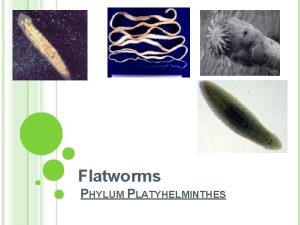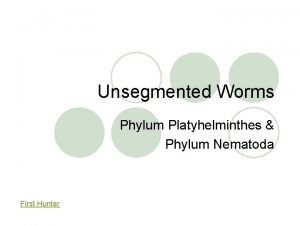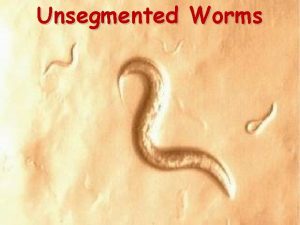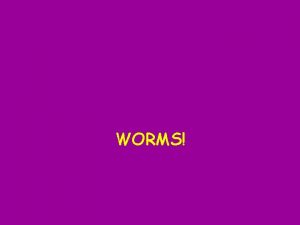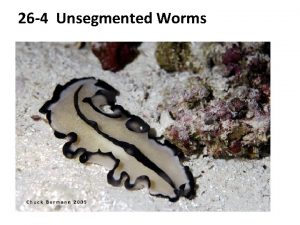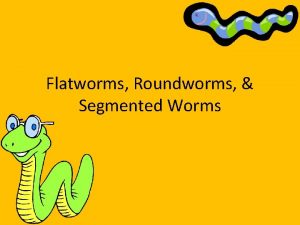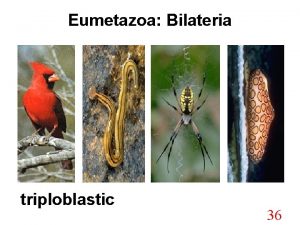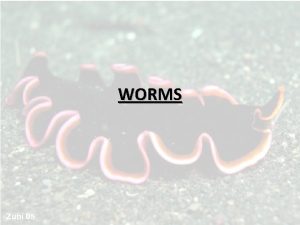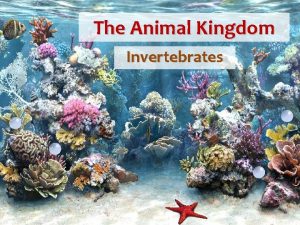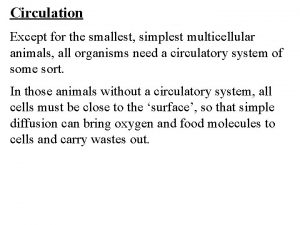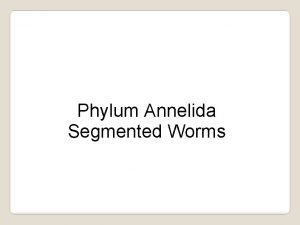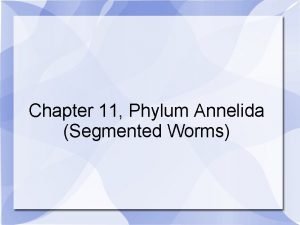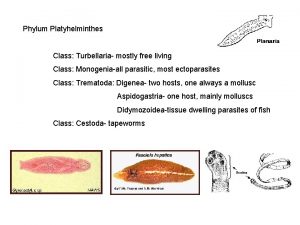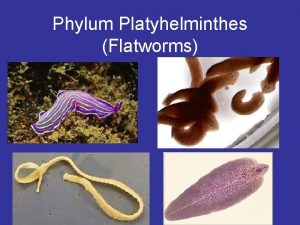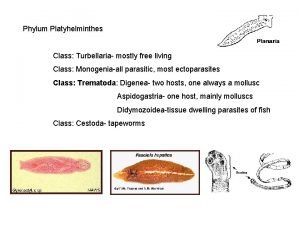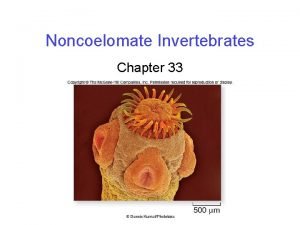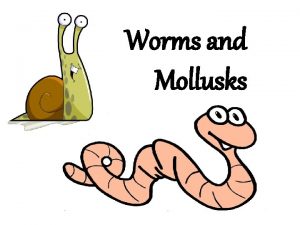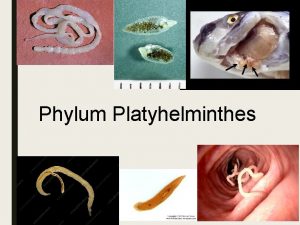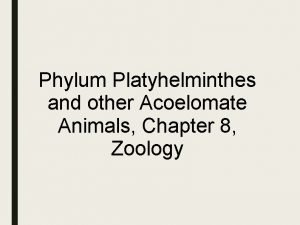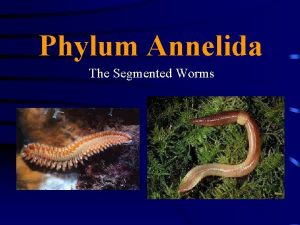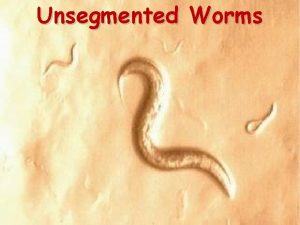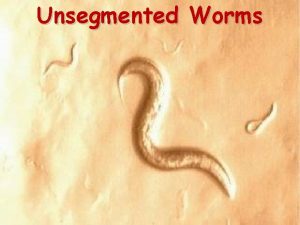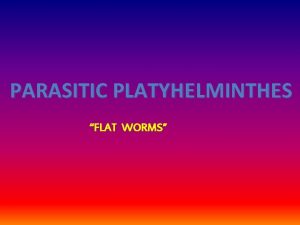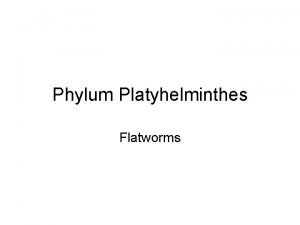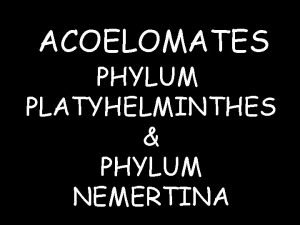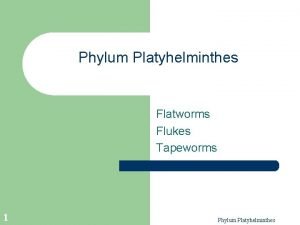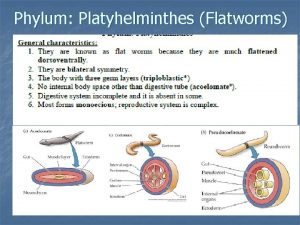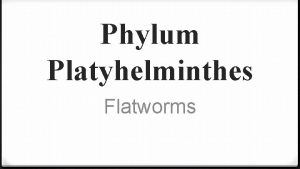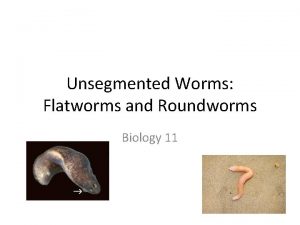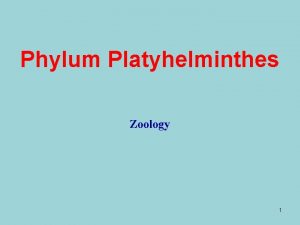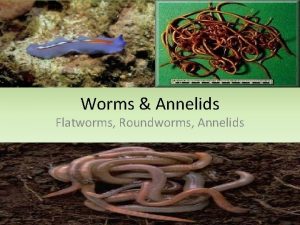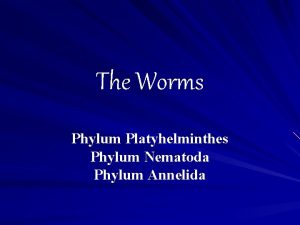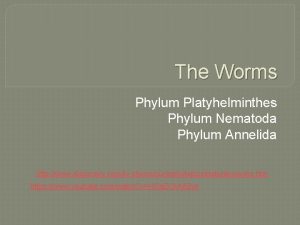Flatworms PHYLUM PLATYHELMINTHES CHARACTERISTICS Unsegmented worms Simplest animals






















- Slides: 22

Flatworms PHYLUM PLATYHELMINTHES


CHARACTERISTICS Unsegmented worms Simplest animals with Bilateral symmetry

No specialized circulatory or respiratory system (uses diffusion to transport oxygen and nutrients) Excretes by diffusion

o Cephalization (sense organs and nerve cells gathered into a head region) o Primitive organ systems with true organs (digestion, excretion)

§Sexual and asexual reproduction (hermaphroditic but don’t self fertilize) §Free-living and parasitic mobile

FREE-LIVING FLATWORMS (AQUATIC) EG. PLANARIA

Planaria – cross-eyed fresh water worm

FREE-LIVING FLATWORMS PLANARIA Both marine and freshwater Most are small (less than cm and few mm thick)

§Primitive nervous system allows for coordination of body movements §Simple eyes that detect light changes (respond to stimuli!!)

Locomotion: cilia help glide through water, muscles allow them to twist and turn Feeding : Some are carnivores , others are scavangers. Gastrovascular cavity with one opening at the end of the muscular tube called a pharynx. (used to suck food in to gastrovascular cavity) Gastrovascular cavity-intestine with many braches. Intestine secrete enzyme to help break down food. Digested food can diffuse from the intestine into nearby cells.

Reproduction Sexual – one worm delivers sperm, while other receives, egg laid in clusters Asexual by fission

PARASITIC FLATWORMS (FLUKES) EG. TAPEWORMS


PARASITIC FLATWORMS TAPEWORMS!! Scolex Proglottids (sections) form at anterior end

Found inside and outside hosts If inside cannot afford to grow too large or it will kill its host. Tapeworm: Have a scolex (head) with several suckers and ring hooks ---attach to intestinal wall. Some can reach up to 30 m in length (found in a sperm whale) Human tapeworms can be 7 m

Live in intestines - Feed on blood, tissue, fluids and pieces of cells Lack : sensory organs, coordination for mobility, digestive system

o Highly developed reproductive system capable of producing hundreds and thousands of egg and sperm. o No digestive tract – absorb food as it passed by

developed a way to maximize absorption of nutrients from their host �being flat �VERY long (which increases their surface area to maximize the absorption of nutrients)

Schistosoma mansoni Life cycle: Swimming larvae Burrow into snail Reproduce asexually Break out of snail Swim in water Bores through skin of human to blood vessels and then intestines Blood vessels leak eggs into intestines Very sick human

Tapeworm life cycle Mature proglottids break off posterior Eggs are released Animal eats contamination Forms a dormant cyst Human eats Hatch in host

 The simplest animals to have body symmetry are
The simplest animals to have body symmetry are Nematoda
Nematoda Unsegmented worms
Unsegmented worms Unsegmented worms meaning
Unsegmented worms meaning A thread like unsegmented worm
A thread like unsegmented worm Platyhelminthes segmented
Platyhelminthes segmented Eumatozoa
Eumatozoa Characteristics of platyhelminthes
Characteristics of platyhelminthes Phylum platyhelminthes characteristics
Phylum platyhelminthes characteristics Platyhelminthes acoelomate
Platyhelminthes acoelomate Simplest multicellular animals
Simplest multicellular animals How do earthworms reproduce
How do earthworms reproduce The characteristics of annelids
The characteristics of annelids Labelled diagram of platyhelminthes
Labelled diagram of platyhelminthes Monogenia
Monogenia Symmetry of tapeworm
Symmetry of tapeworm Hellmin
Hellmin Platyhelminthes
Platyhelminthes Invertebrate phylogeny
Invertebrate phylogeny Worms and mollusks
Worms and mollusks Platyhelminthes
Platyhelminthes Characteristics of platyhelminthes
Characteristics of platyhelminthes Segmented worms characteristics
Segmented worms characteristics
